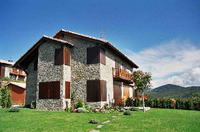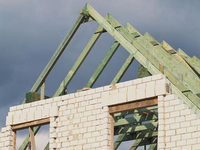

A ‘new’ house is generally defined as one built in the last five years, which is also the legal definition. Although new properties may lack the charm and character of older buildings (see above), they offer attractive financial and other advantages.
Here is a list of those advantages.

The standard of new buildings in France is strictly regulated and houses are built to official quality standards. They’re built to higher specifications than old houses and usually include roof, cavity and under-floor insulation, double-glazing, central heating, and ventilation and dehumidifying systems – it can cost up to three times as much to heat an old home without proper insulation as to heat a modern home. New properties are also covered by a ten-year guarantee (garantie décennale) against structural defects and it’s against the law to sell a new house without a warranty. Other systems and equipment are covered by a minimum two-year warranty.
It’s often cheaper to buy a new home than to restore a derelict property, as the price is fixed, unlike the cost of renovation which can – and usually does – soar way beyond original estimates.
Most new buildings use low maintenance materials and must (by law) have good insulation and ventilation, keeping them warmer in winter and cooler in summer. The French government encourages the building of energy-efficient homes, and France builds more new homes than most other European countries (some 60 per cent of French homes have been built since 1945). Security is a priority for most new developments (which usually have security gates) and homes often have security blinds and other security features.
On the other hand, there are a few disadvantages to buying a new home, including the following:
Most new properties are sold by developers (promoteurs) and builders, although they’re also marketed by estate agents. The monthly magazine Living France has details of ‘new-builds’ of all types in all parts of France. All new developments and builders must be underwritten by a bank (garantie extrinsèque) or the developer himself (garantie intrinsèque), who must meet certain liquidity and other requirements. These guarantees (known as garanties d’achèvement) protect buyers from defaulting builders and developers. Where applicable, the deposit is made out to the underwriting bank and cannot be used by the developer. It’s possible to check a developer’s financial status, although your best insurance when buying a new property is the reputation of the developer or builder. Most new developments have a sales office (bureau de vente) and a show house or apartment (maison/appartement témoin).

When buying a new property in a development, you’re usually obliged to commit to a purchase before it’s completed (or even before it’s begun!) – a process known in English as buying off plan (also confusingly called ‘on plan’) and in French as une vente en état futur d’achèvement/VEFA (‘a sale in a future state of completion’). In fact, if a development is built and largely unsold, particularly a quality development in a popular area, it usually means that there’s something wrong with it!
Buying a home that hasn’t yet been built may seem a risky business, and there are cases of purchasers being disappointed with their purchase or even being let down or cheated by builders and developers. The most common problems are:
Other disadvantages of buying off plan include VAT at 19.6 per cent on building costs, although this is usually included in the price quoted to you, and the fact that you must start paying for your home long before you can occupy in it.
Nevertheless, the purchase procedure is usually safe and you can build into your contract clauses that protect you from most of the above problems. Before signing a contract, you should check the following:
Note also that the purchase procedure for a property yet to be built is different from that for a finished home.
On the other hand, there can be several advantages to buying off plan as opposed to buying a completed property. Off-plan properties are generally cheaper than built homes. You can usually choose your bathroom suite, kitchen, fireplace, wallpaper, paint, wall and floor tiles, and carpet in bedrooms, all of which may be included in the price. You may also be able to alter the interior room layout, although this will increase the price, but you won’t be able to make major structural alterations or changes of material or design. Most developers will negotiate over the price or include ‘free’ extras (such as a fitted kitchen when it isn’t included in the price), particularly if a development isn’t selling well.
Note that any changes or additions to a property, such as including an American kitchen, a chimney or an additional shower room, should be made during the design stage, as they will cost much more to install later. All fixtures and fittings will, of course, be brand new, and you will benefit from modern insulation, ventilation, heating and other materials and systems. And, of course, the building will have a ten-year guarantee. You will also pay a lower deposit and lower registration fees on an off-plan home, which will be exempt from property tax for two years from 1st January following the completion date.
Buying ‘new’ doesn’t necessarily mean buying a brand new home where you’re the first occupant. There can be many advantages in buying a modern resale home rather than a brand new one, including better value, an established development with a range of local services and facilities in place, more individual design and style, no ‘teething troubles’, furniture and other extras included in the price, a mature garden and trees, and a larger plot. With a resale property you can see exactly what you will get for your money and the previous owners may have made improvements or added extras such as a swimming pool that may not be fully reflected in the asking price. The disadvantages of buying a resale home depend on its age and how well it has been maintained. They can include a poor state of repair and the need for refurbishment, redecoration or new carpets; inferior build quality and design, no warranty (i.e. with a home that’s more than ten years old), termite or other infestations, and (in the case of a community property) the possibility of incurring high assessments for repairs.
This article is an extract from Buying a home in France. Click here to get a copy now.